2017 TOYOTA TACOMA charging
[x] Cancel search: chargingPage 422 of 640
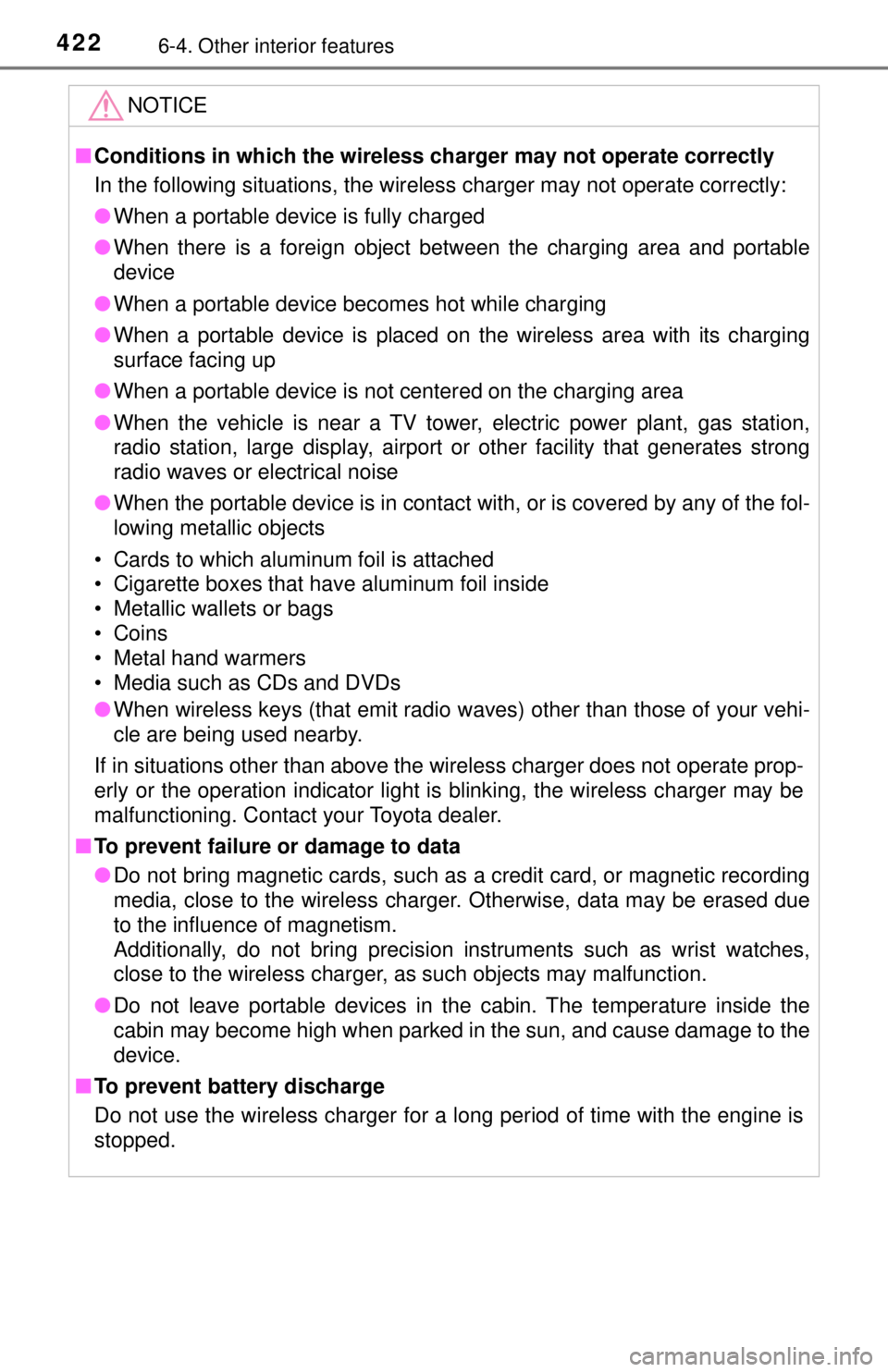
4226-4. Other interior features
NOTICE
■Conditions in which the wireless charger may not operate correctly
In the following situations, the wireless charger may not operate correctly:
● When a portable device is fully charged
● When there is a foreign object between the charging area and portable
device
● When a portable device becomes hot while charging
● When a portable device is placed on the wireless area with its charging
surface facing up
● When a portable device is not centered on the charging area
● When the vehicle is near a TV tower, electric power plant, gas station,
radio station, large display, airport or other facility that generates strong
radio waves or electrical noise
● When the portable device is in contact with, or is covered by any of the fol-
lowing metallic objects
• Cards to which aluminum foil is attached
• Cigarette boxes that have aluminum foil inside
• Metallic wallets or bags
• Coins
• Metal hand warmers
• Media such as CDs and DVDs
● When wireless keys (that emit radio waves) other than those of your vehi-
cle are being used nearby.
If in situations other than above the wireless charger does not operate prop-
erly or the operation indicator light is blinking, the wireless charger may be
malfunctioning. Contact your Toyota dealer.
■ To prevent failure or damage to data
● Do not bring magnetic cards, such as a credit card, or magnetic recording
media, close to the wireless charger. Otherwise, data may be erased due
to the influence of magnetism.
Additionally, do not bring precision instruments such as wrist watches,
close to the wireless charger, as such objects may malfunction.
● Do not leave portable devices in the cabin. The temperature inside the
cabin may become high when parked in the sun, and cause damage to the
device.
■ To prevent battery discharge
Do not use the wireless charger for a long period of time with the engine is
stopped.
Page 463 of 640
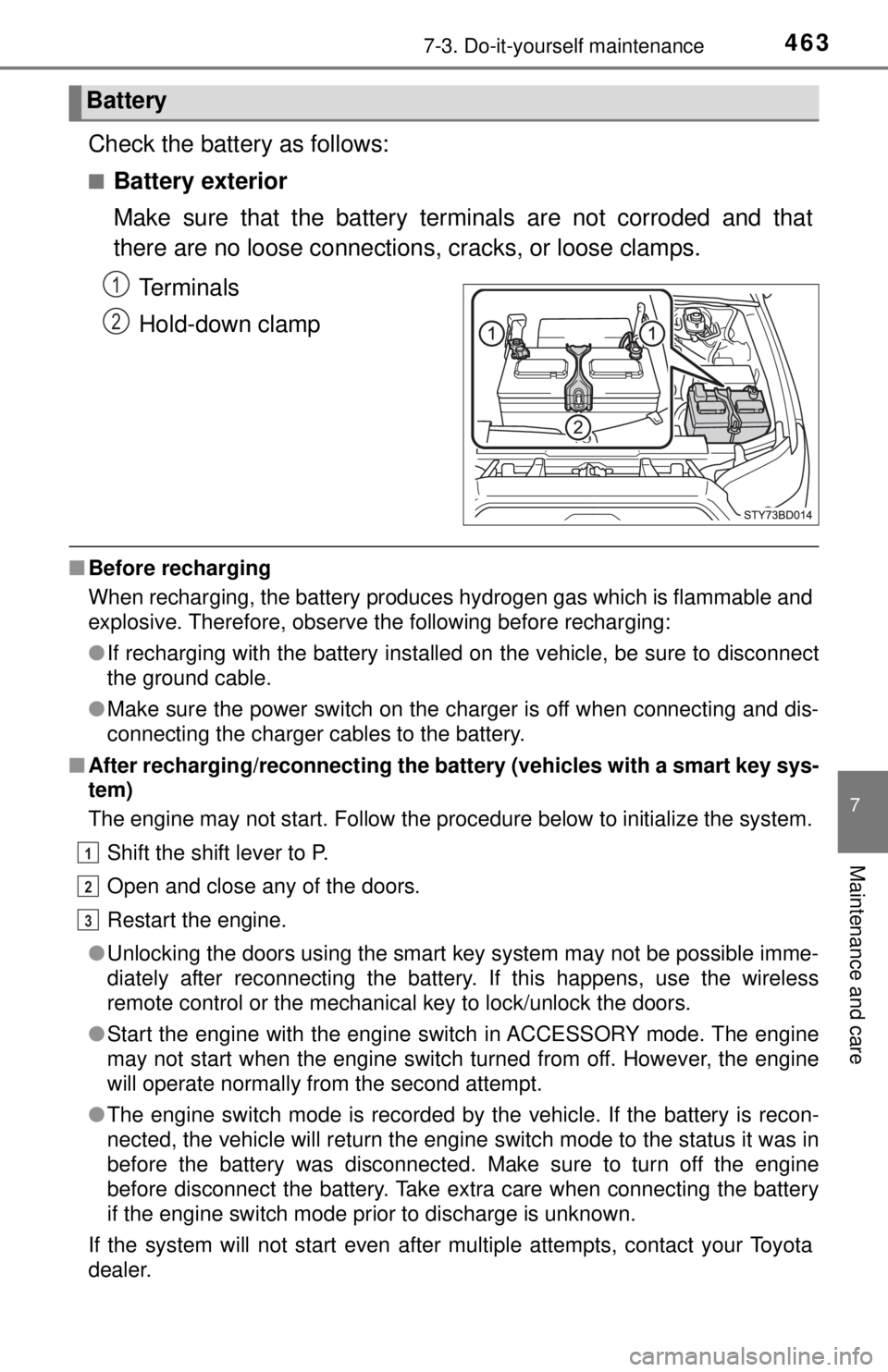
4637-3. Do-it-yourself maintenance
7
Maintenance and care
Check the battery as follows:
■Battery exterior
Make sure that the battery terminals are not corroded and that
there are no loose connections, cracks, or loose clamps.
Terminals
Hold-down clamp
■ Before recharging
When recharging, the battery produces hydrogen gas which is flammable and
explosive. Therefore, observe the following before recharging:
●If recharging with the battery installed on the vehicle, be sure to disconnect
the ground cable.
● Make sure the power switch on the charger is off when connecting and dis-
connecting the charger cables to the battery.
■ After recharging/reconnecting the ba ttery (vehicles with a smart key sys-
tem)
The engine may not start. Follow the procedure below to initialize the system.
Shift the shift lever to P.
Open and close any of the doors.
Restart the engine.
● Unlocking the doors using the smart key system may not be possible imme-
diately after reconnecting the battery. If this happens, use the wireless
remote control or the mechanical key to lock/unlock the doors.
● Start the engine with the engine switch in ACCESSORY mode. The engine
may not start when the engine switch turned from off. However, the engine
will operate normally from the second attempt.
● The engine switch mode is recorded by the vehicle. If the battery is recon-
nected, the vehicle will return the engine switch mode to the status it was in
before the battery was disconnected. Make sure to turn off the engine
before disconnect the battery. Take extra care when connecting the battery
if the engine switch mode prior to discharge is unknown.
If the system will not start even after multiple attempts, contact your Toyota
dealer.
Battery
1
2
1
2
3
Page 464 of 640
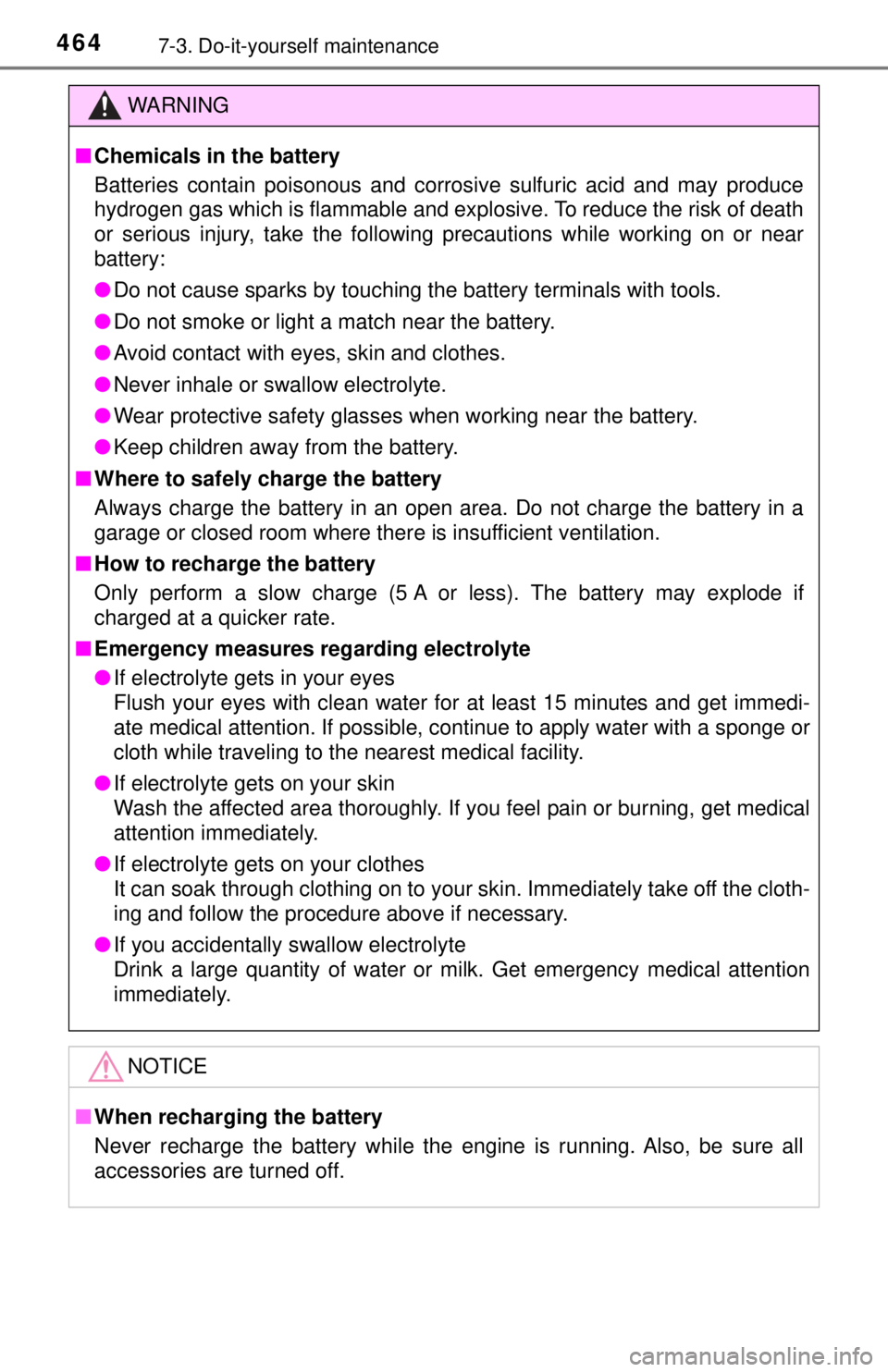
4647-3. Do-it-yourself maintenance
WARNING
■Chemicals in the battery
Batteries contain poisonous and corrosive sulfuric acid and may produce
hydrogen gas which is flammable and explosive. To reduce the risk of death
or serious injury, take the following precautions while working on or near
battery:
● Do not cause sparks by touching the battery terminals with tools.
● Do not smoke or light a match near the battery.
● Avoid contact with eyes, skin and clothes.
● Never inhale or swallow electrolyte.
● Wear protective safety glasses when working near the battery.
● Keep children away from the battery.
■ Where to safely charge the battery
Always charge the battery in an open area. Do not charge the battery in a
garage or closed room where there is insufficient ventilation.
■ How to recharge the battery
Only perform a slow charge (5 A or less). The battery may explode if
charged at a quicker rate.
■ Emergency measures regarding electrolyte
● If electrolyte gets in your eyes
Flush your eyes with clean water for at least 15 minutes and get immedi-
ate medical attention. If possible, continue to apply water with a sponge or
cloth while traveling to the nearest medical facility.
● If electrolyte gets on your skin
Wash the affected area thoroughly. If you feel pain or burning, get medical
attention immediately.
● If electrolyte gets on your clothes
It can soak through clothing on to your skin. Immediately take off the cloth-
ing and follow the procedure above if necessary.
● If you accidentally swallow electrolyte
Drink a large quantity of water or milk. Get emergency medical attention
immediately.
NOTICE
■When recharging the battery
Never recharge the battery while the engine is running. Also, be sure all
accessories are turned off.
Page 514 of 640
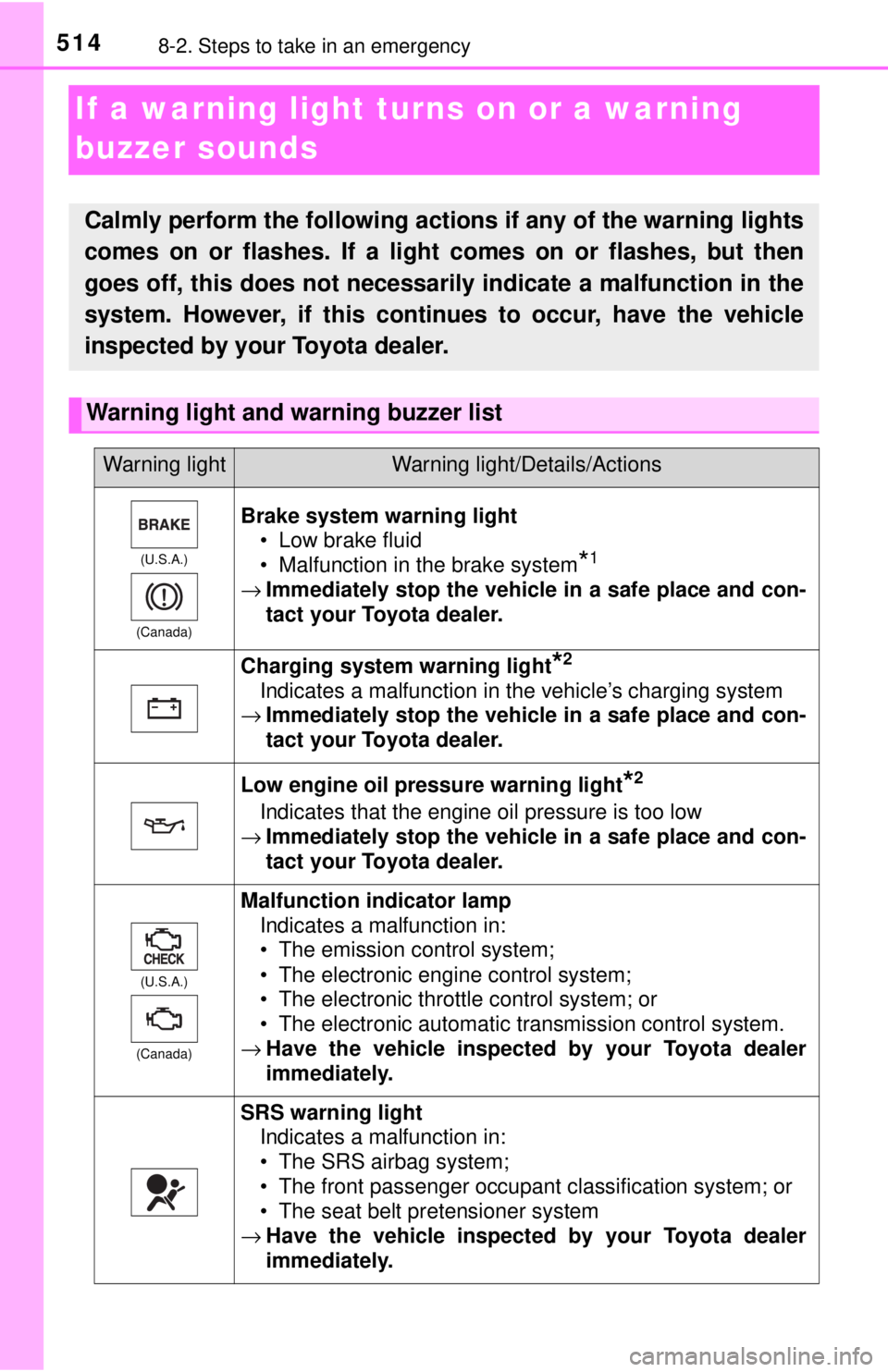
5148-2. Steps to take in an emergency
If a warning light turns on or a warning
buzzer sounds
Calmly perform the following actions if any of the warning lights
comes on or flashes. If a light comes on or flashes, but then
goes off, this does not necessarily indicate a malfunction in the
system. However, if this continues to occur, have the vehicle
inspected by your Toyota dealer.
Warning light and warning buzzer list
Warning lightWarning light/Details/Actions
(U.S.A.)
(Canada)
Brake system warning light • Low brake fluid
• Malfunction in the brake system
*1
→ Immediately stop the vehicle in a safe place and con-
tact your Toyota dealer.
Charging system warning light*2
Indicates a malfunction in the vehicle’s charging system
→ Immediately stop the vehicle in a safe place and con-
tact your Toyota dealer.
Low engine oil pressure warning light*2
Indicates that the engine oil pressure is too low
→ Immediately stop the vehicle in a safe place and con-
tact your Toyota dealer.
(U.S.A.)
(Canada)
Malfunction indicator lamp Indicates a malfunction in:
• The emission control system;
• The electronic engine control system;
• The electronic throttle control system; or
• The electronic automatic transmission control system.
→ Have the vehicle inspected by your Toyota dealer
immediately.
SRS warning light
Indicates a malfunction in:
• The SRS airbag system;
• The front passenger occupant classification system; or
• The seat belt pretensioner system
→ Have the vehicle inspected by your Toyota dealer
immediately.
Page 524 of 640
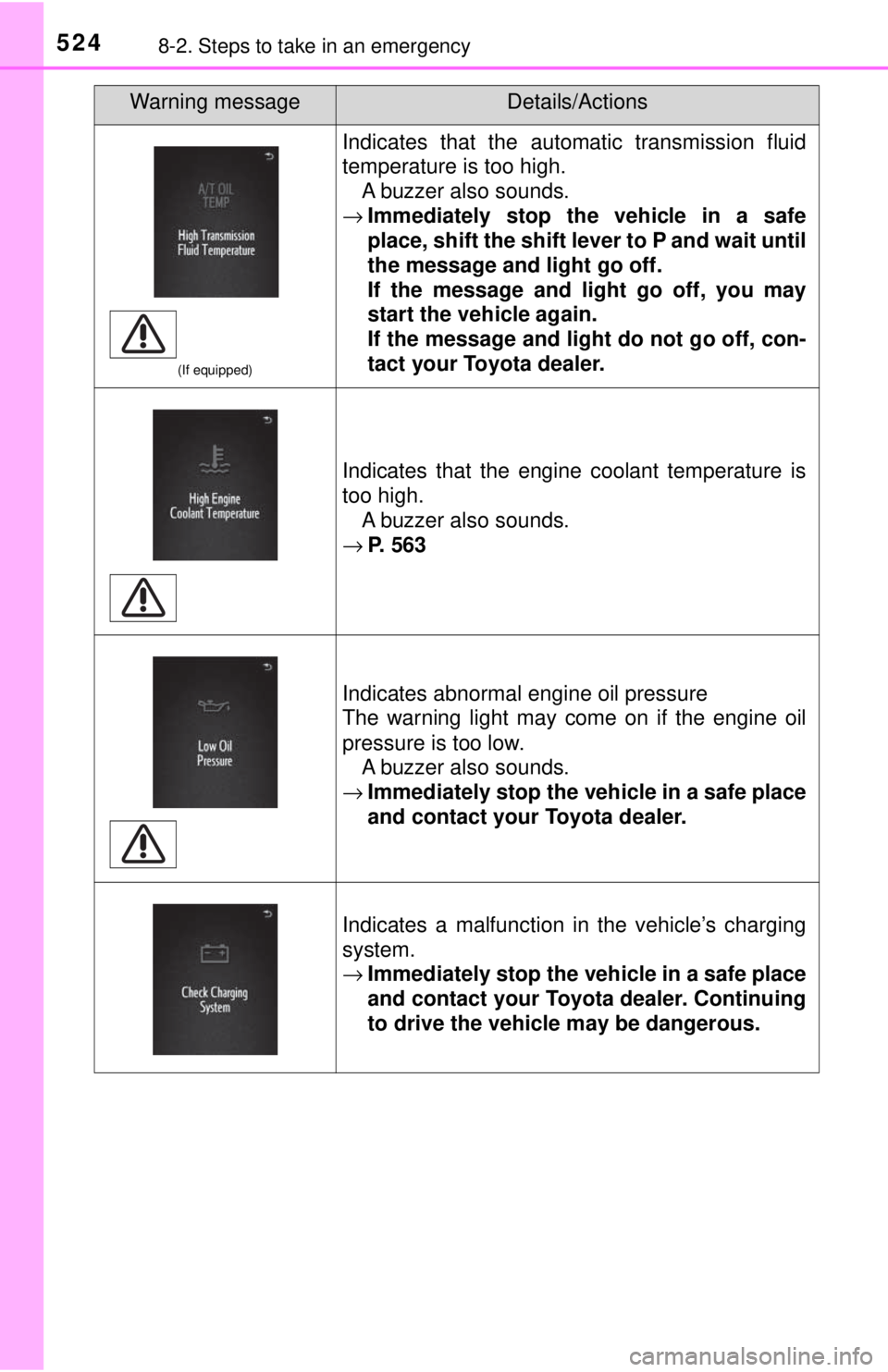
5248-2. Steps to take in an emergency
(If equipped)
Indicates that the automatic transmission fluid
temperature is too high.A buzzer also sounds.
→ Immediately stop the vehicle in a safe
place, shift the shift lever to P and wait until
the message and light go off.
If the message and ligh t go off, you may
start the vehicle again.
If the message and light do not go off, con-
tact your Toyota dealer.
Indicates that the engine coolant temperature is
too high. A buzzer also sounds.
→ P. 563
Indicates abnormal engine oil pressure
The warning light may come on if the engine oil
pressure is too low.
A buzzer also sounds.
→ Immediately stop the vehicle in a safe place
and contact your Toyota dealer.
Indicates a malfunction in the vehicle’s charging
system.
→ Immediately stop the vehicle in a safe place
and contact your Toyota dealer. Continuing
to drive the vehicle may be dangerous.
Warning messageDetails/Actions
Page 561 of 640
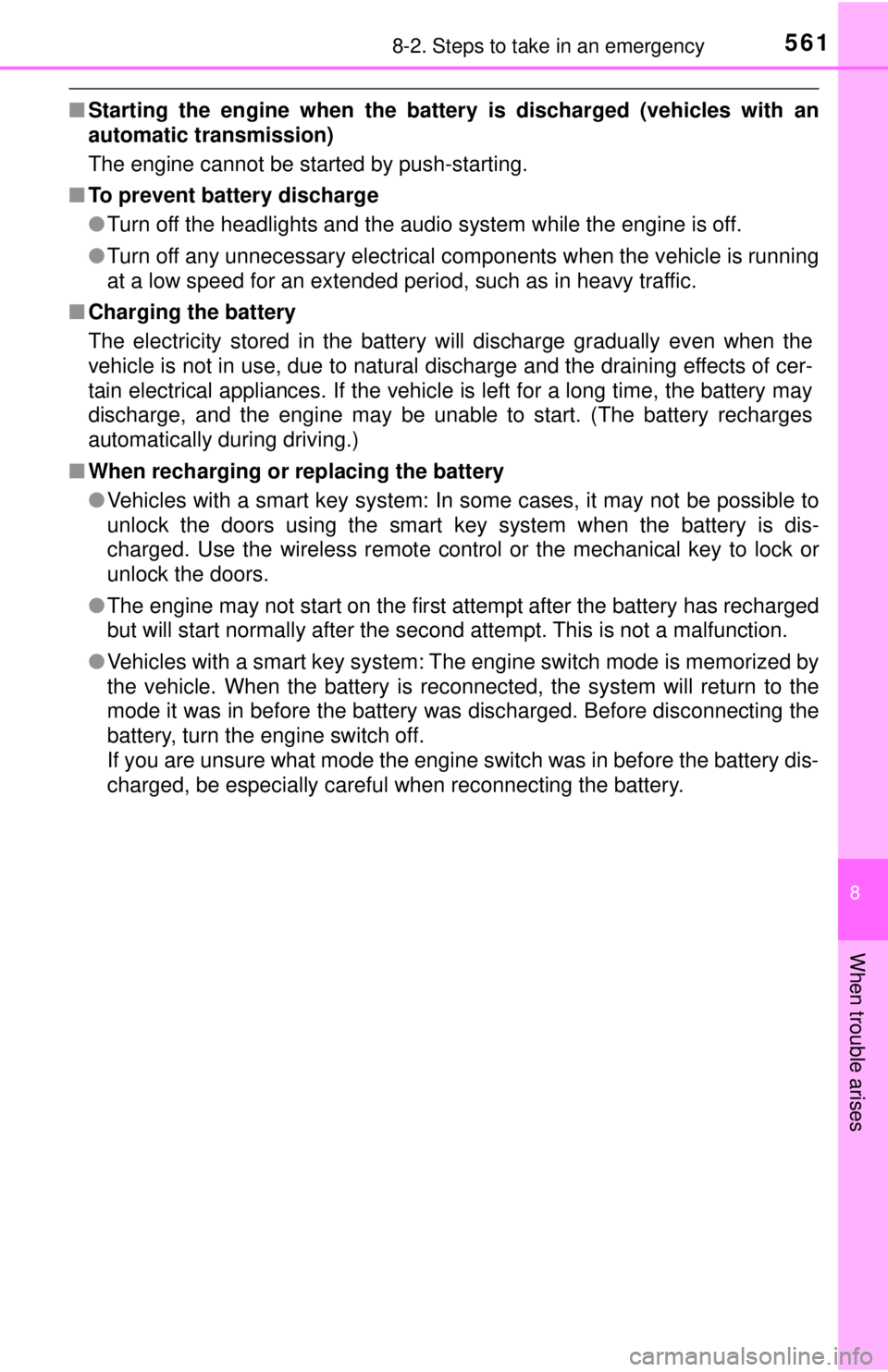
5618-2. Steps to take in an emergency
8
When trouble arises
■Starting the engine when the batt ery is discharged (vehicles with an
automatic transmission)
The engine cannot be started by push-starting.
■ To prevent battery discharge
●Turn off the headlights and the audio system while the engine is off.
● Turn off any unnecessary electrical components when the vehicle is running
at a low speed for an extended period, such as in heavy traffic.
■ Charging the battery
The electricity stored in the battery will discharge gradually even when the
vehicle is not in use, due to natural discharge and the draining effects of cer-
tain electrical appliances. If the vehicle is left for a long time, the battery may
discharge, and the engine may be unable to start. (The battery recharges
automatically during driving.)
■ When recharging or replacing the battery
●Vehicles with a smart key system: In some cases, it may not be possible to
unlock the doors using the smart key system when the battery is dis-
charged. Use the wireless remote control or the mechanical key to lock or
unlock the doors.
● The engine may not start on the first attempt after the battery has recharged
but will start normally after the second attempt. This is not a malfunction.
● Vehicles with a smart key system: The engine switch mode is memorized by
the vehicle. When the battery is reconnected, the system will return to the
mode it was in before the battery was discharged. Before disconnecting the
battery, turn the engine switch off.
If you are unsure what mode the engine switch was in before the battery dis-
charged, be especially careful when reconnecting the battery.
Page 576 of 640
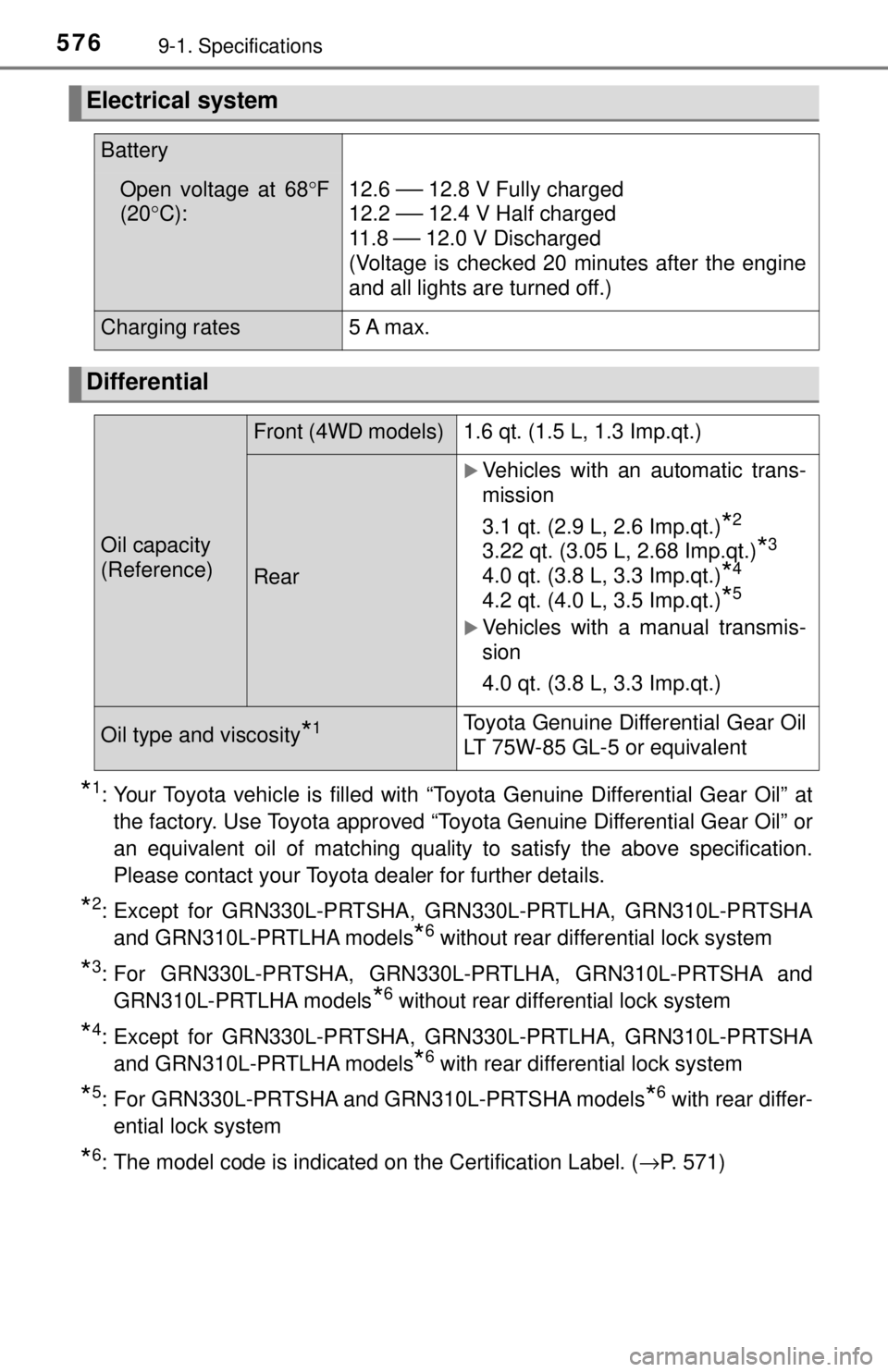
5769-1. Specifications
*1: Your Toyota vehicle is filled with “Toyota Genuine Differential Gear Oil” atthe factory. Use Toyota approved “Toyota Genuine Differential Gear Oil” or
an equivalent oil of matching quality to satisfy the above specification.
Please contact your Toyota dealer for further details.
*2: Except for GRN330L-PRTSHA, GRN330L-PRTLHA, GRN310L-PRTSHA
and GRN310L-PRTLHA models
*6 without rear differential lock system
*3: For GRN330L-PRTSHA, GRN330L -PRTLHA, GRN310L-PRTSHA and
GRN310L-PRTLHA models
*6 without rear differential lock system
*4: Except for GRN330L-PRTSHA, GRN330L-PRTLHA, GRN310L-PRTSHA
and GRN310L-PRTLHA models
*6 with rear differential lock system
*5: For GRN330L-PRTSHA and GRN310L-PRTSHA models*6 with rear differ-
ential lock system
*6: The model code is indicated on the Certification Label. ( →P. 571)
Electrical system
Battery
Open voltage at 68°F
(20° C):12.6 ⎯ 12.8 V Fully charged
12.2
⎯ 12.4 V Half charged
11 . 8
⎯ 12.0 V Discharged
(Voltage is checked 20 minutes after the engine
and all lights are turned off.)
Charging rates5 A max.
Differential
Oil capacity
(Reference)
Front (4WD models) 1.6 qt. (1.5 L, 1.3 Imp.qt.)
Rear
Vehicles with an automatic trans-
mission
3.1 qt. (2.9 L, 2.6 Imp.qt.)
*2
3.22 qt. (3.05 L, 2.68 Imp.qt.)*3
4.0 qt. (3.8 L, 3.3 Imp.qt.)*4
4.2 qt. (4.0 L, 3.5 Imp.qt.)*5
Vehicles with a manual transmis-
sion
4.0 qt. (3.8 L, 3.3 Imp.qt.)
Oil type and viscosity*1Toyota Genuine Differential Gear Oil
LT 75W-85 GL-5 or equivalent
Page 639 of 640
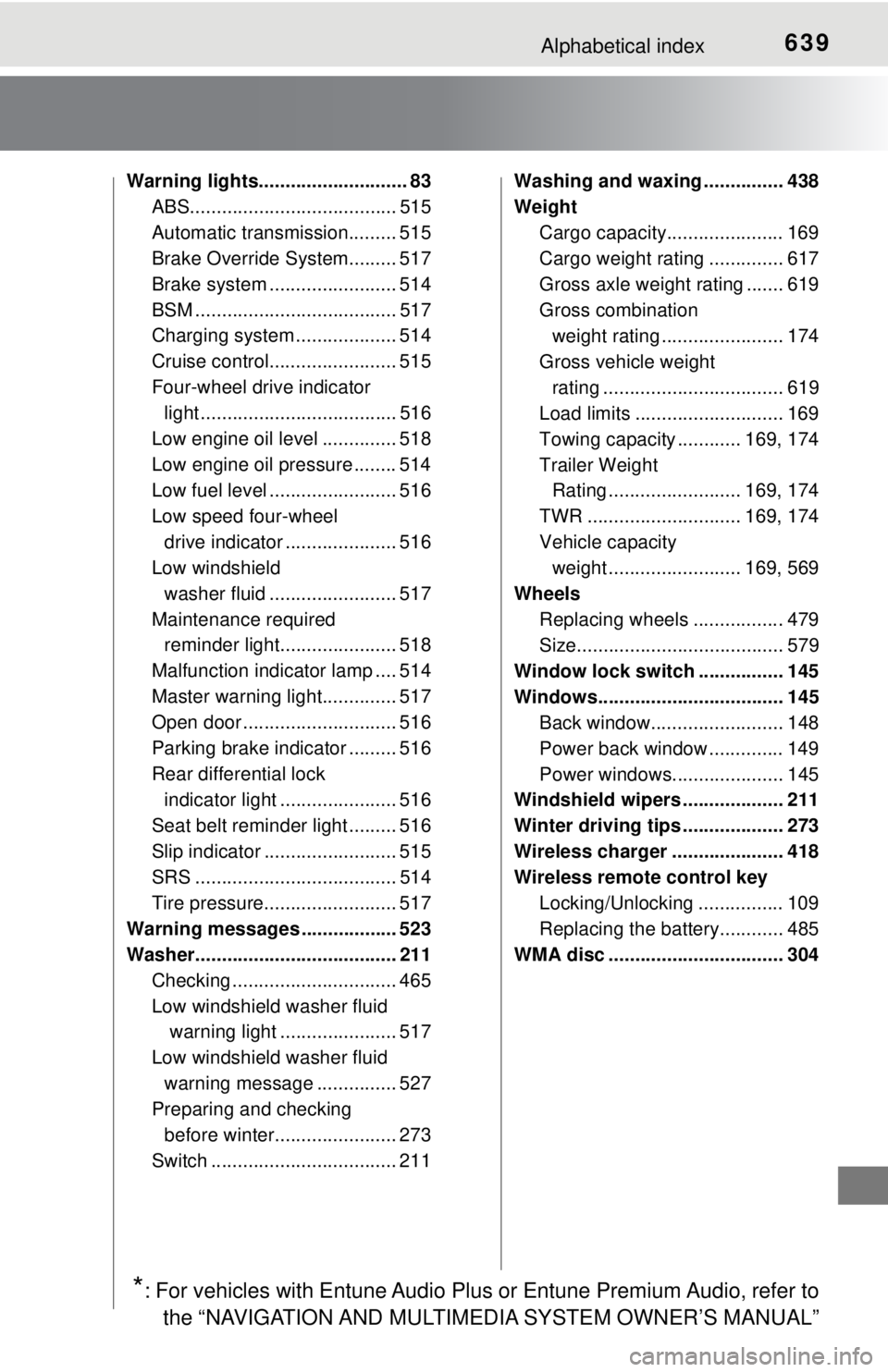
639Alphabetical index
Warning lights............................ 83ABS....................................... 515
Automatic transmission......... 515
Brake Override System......... 517
Brake system ....... ................. 514
BSM ...................................... 517
Charging system ................... 514
Cruise control........................ 515
Four-wheel drive indicator light ..................................... 516
Low engine oil level .............. 518
Low engine oil pressure ........ 514
Low fuel level ........................ 516
Low speed four-wheel drive indicator ..................... 516
Low windshield
washer fluid ........................ 517
Maintenance required reminder light...................... 518
Malfunction indicator lamp .... 514
Master warning light.............. 517
Open door ............................. 516
Parking brake indicator ......... 516
Rear differential lock indicator light ...................... 516
Seat belt reminder light ......... 516
Slip indicator ......................... 515
SRS ...................................... 514
Tire pressure......................... 517
Warning messages .................. 523
Washer...................................... 211 Checking ............................... 465
Low windshield washer fluid warning light ...................... 517
Low windshield washer fluid warning message ............... 527
Preparing and checking
before winter....................... 273
Switch ................................... 211 Washing and waxing ............... 438
Weight
Cargo capacity...................... 169
Cargo weight rating .............. 617
Gross axle weight rating ....... 619
Gross combination weight rating ....................... 174
Gross vehicle weight rating .................................. 619
Load limits ............................ 169
Towing capacity ............ 169, 174
Trailer Weight Rating ......................... 169, 174
TWR ............................. 169, 174
Vehicle capacity weight ......................... 169, 569
Wheels Replacing wheels ................. 479
Size....................................... 579
Window lock switch ................ 145
Windows................................... 145 Back window......................... 148
Power back window .............. 149
Power windows..................... 145
Windshield wipers ................... 211
Winter driving tips ................... 273
Wireless charger ..................... 418
Wireless remote control key
Locking/Unlocking ................ 109
Replacing the battery............ 485
WMA disc ................................. 304
*: For vehicles with Entune Audio Plus or Entune Premium Audio, refer to the “NAVIGATION AND MULTIMEDIA SYSTEM OWNER’S MANUAL”